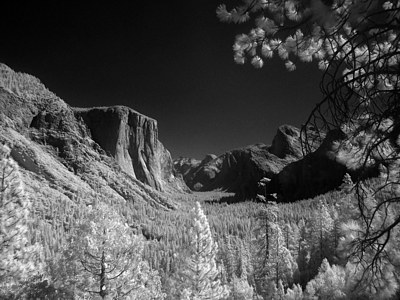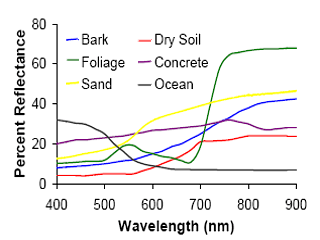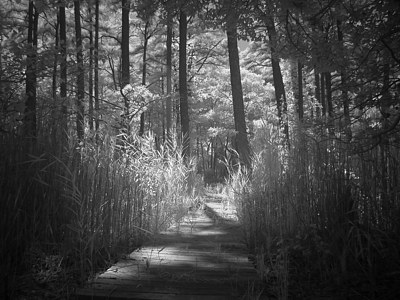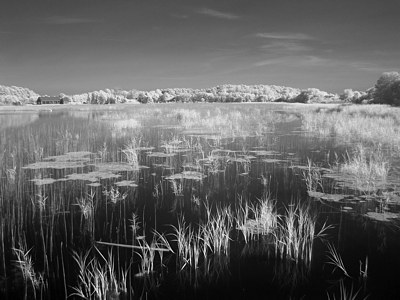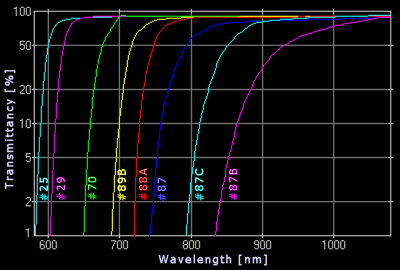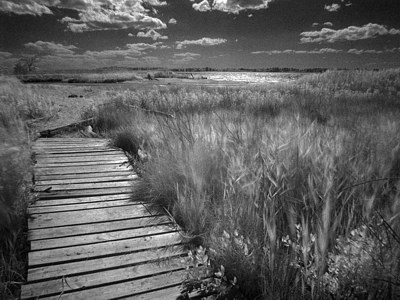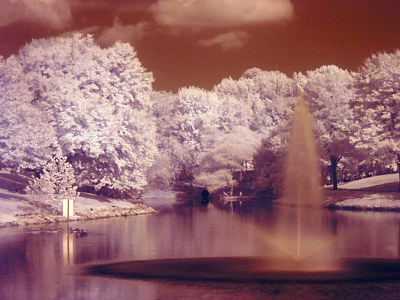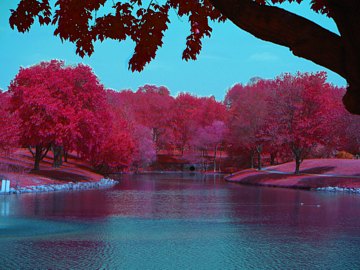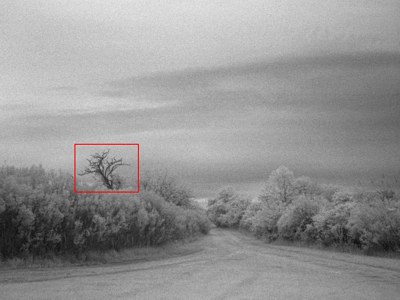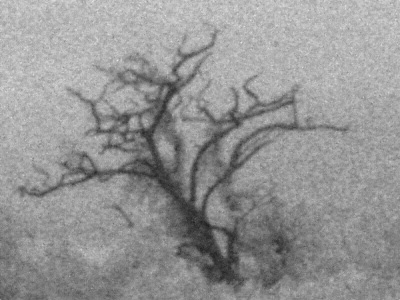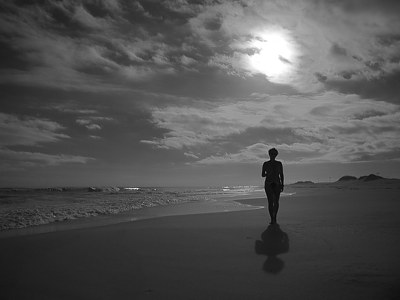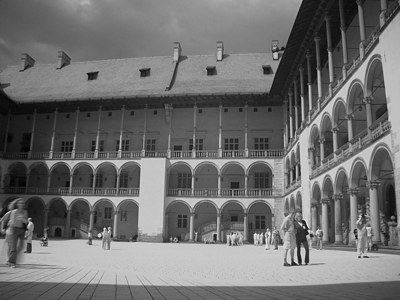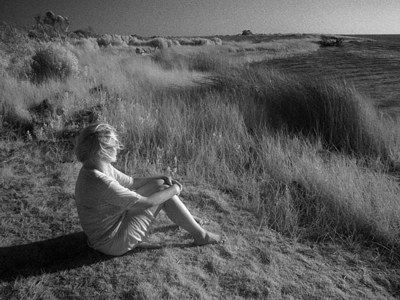|
Fogging
Certain cameras or lenses may exhibit some fogging, or image areas with extra exposure (for example, a bright central spot seen with many Canon lenses). This may be due to light scattered from inner surfaces of the lens, or to some peculiarities of anti-reflective lens coating which was not really designed for infrared. Sometimes the blackness of internal surfaces of the lens tube or mirror chamber may be "not black enough" in infrared. (I experienced the last effect a few years ago with an Olympus E-10, where the extreme 15% or so of many frames was ghosted.)
Sometimes it happens to all cameras of a given model, sometimes — just to a particular specimen or a particular lens. Camera makers are not worried about this: very few users ever venture into the IR realm, and this is a mass market after all. There is no way to avoid this problem; once again, check an IR filter on your camera/lens combination before buying.
Note to SLR users: regardless of that effect, the image may be fogged, or otherwise affected, by the light entering through the viewfinder in spite of the raised mirror) and reaching the sensor after being scattered around the mirror chamber. To avoid that, close the eyepiece shutter before the exposure, or use the included eyepiece cover (or, at the very least, shield the eyepiece with your hand or hat). Users of non-SLR cameras, obviously, do not have to worry about this.
Gisle Hannemyr provides a list of lenses checked to produce a hot spot or fogging (or to be free of these effects) in his Digital Infrared Resource Page.
Focusing
The focal length of your lens (and therefore the proper focus setting) depends on the wavelength. Lens makers try to keep that dependency to a minimum (achromatic lenses), but only within the visible light spectrum. A lens focused in visible light will be somewhat off-focus in infrared. Many film-era lenses had a separate focus marker on the barrel, to be used in infrared photography.
With autofocus, like with autoexposure, the outcome depends on the type of camera, although the difference is not as drastic. (Remember, we are talking about non-modified cameras here, where an IR filter is used on the lens.)
Non-SLR cameras have an easier job here. Autofocus is performed in the image sensor plane, by contrast detection. This means the circuitry will properly detect when the image is in focus, regardless of the light type. There may be a problem with the amount of light available for the job, but not with its kind; the AF action may be slower and less reliable, but there will be no systematic shift. If your camera is capable of autofocusing in low light down to EV 0 or not much above, you'll be just fine. Sort of.
Just in case, I would recommend taking more than one picture, every time forcing the camera to re-focus. This will increase your chances of getting at least one properly focused image.
In SLRs the AF is done by dedicated sensors behind a system of mirrors. These sensors are at the same effective distance from the lens as the imager. This should, in principle, work OK, as both the AF sensors and the imager are getting infrared light only. There may be, however, some inaccuracy caused by the fact that both sensors are receiving somewhat different kind of infrared (remember the anti-IR filter on top of the imager!), so both focus planes will be shifted with respect to each other: what the AF sensor will see as in focus, the imager may see somewhat out-of-focus.
The difference is not as large as the one between visible and IR light, so we just have to live with this (IR-adapted cameras, without a filter on the lens, face much more of a problem here). Just in case, stepping the lens down for more depth of field, is a reasonable precaution.
Some SLRs with the Live View feature offer an additional AF-by-imager mode. In that case, the system works exactly as in a non-SLR camera, just fine — as long as the camera does not do the final focusing, just before opening the shutter, using the "regular" AF sensors.
Manual focusing by scale is not really useful here, although with a bit of patience you may find the right setting for a given lens used for landscape shooting. If in doubt, try setting focus a little closer than the actual subject distance: at the equivalent focal length of 50 mm use about 4-5 m instead of infinity — but this actually depends on the particular lens.
Depth of field may, to a large extent, help masking the lack of proper focus. In case of problems, try to use wide zoom settings and shoot in aperture priority at F/8 or so; this may help.
You can run but you can't hide: at small apertures (large F-numbers) the image resolution is negatively affected by diffraction effects. This effect is more visible (i.e., starts at larger apertures) in infrared. Its magnitude depends on the ratio of the (absolute) aperture size to the average wavelength of light used for the image. That wavelength is about 50% more for near-infrared than for visible light (850 nm or so versus 550 nm; remember that IR wavelength is limited by the anti-IR filter), hence the difference in usable apertures will be about one F-stop, maybe a bit more. This means that if you could (or chose to) use apertures up to F/11 in visible light (with a given lens), in infrared the limit will be F/8 or F/7. Still, it is often easier to live with diffraction than with an out-of-focus image.
While smaller imagers suffer from this at lower F-numbers, they also show more depth of field; both effects exactly compensate each other.
Postprocessing
The response of red, green, and blue photosites in the CCD, and therefore the color image recorded by the camera, is the result of a subtle play between the transmittances of three (!) filter layers involved here: (1) the IR filter mounted on the lens; (2) the anti-IR filter in front of the CCD; (3) the tiny red, green, and blue filters in front of each photosite of the sensor.
No wonder that the (false) colors of an image shot in infrared may vary from one camera model to another, and from filter to filter used.
While some cameras, especially when used with filters darker than #89B, may come up with color images which some may find pleasing, in most cases the images will have a very strong red or purple-red tint, being recorded mostly in the red component. This is certainly true of all Olympus models I have used, but not only. The effect may also depend on the sensor gain (ISO setting) and color balance, but not by much.
Therefore usually you would like to translate your IR pictures into gray scale, i.e., to black-and-white (or sepia) monochrome.
Depending on your postprocessing program, you can do it by desaturating the image, or changing its mode to 16-bit monochrome, or applying a duotone filter.
After the conversion you will usually want to restore the tonal range of your picture (doing that before does not make much sense, as this usually leads to overloading of the red channel and burning out the highlights). Then, after denoising (see below) and, if needed, some sharpening, you may tint your monochrome picture to sepia or something else, although I usually prefer my IR pictures straight black-and-white.
| 